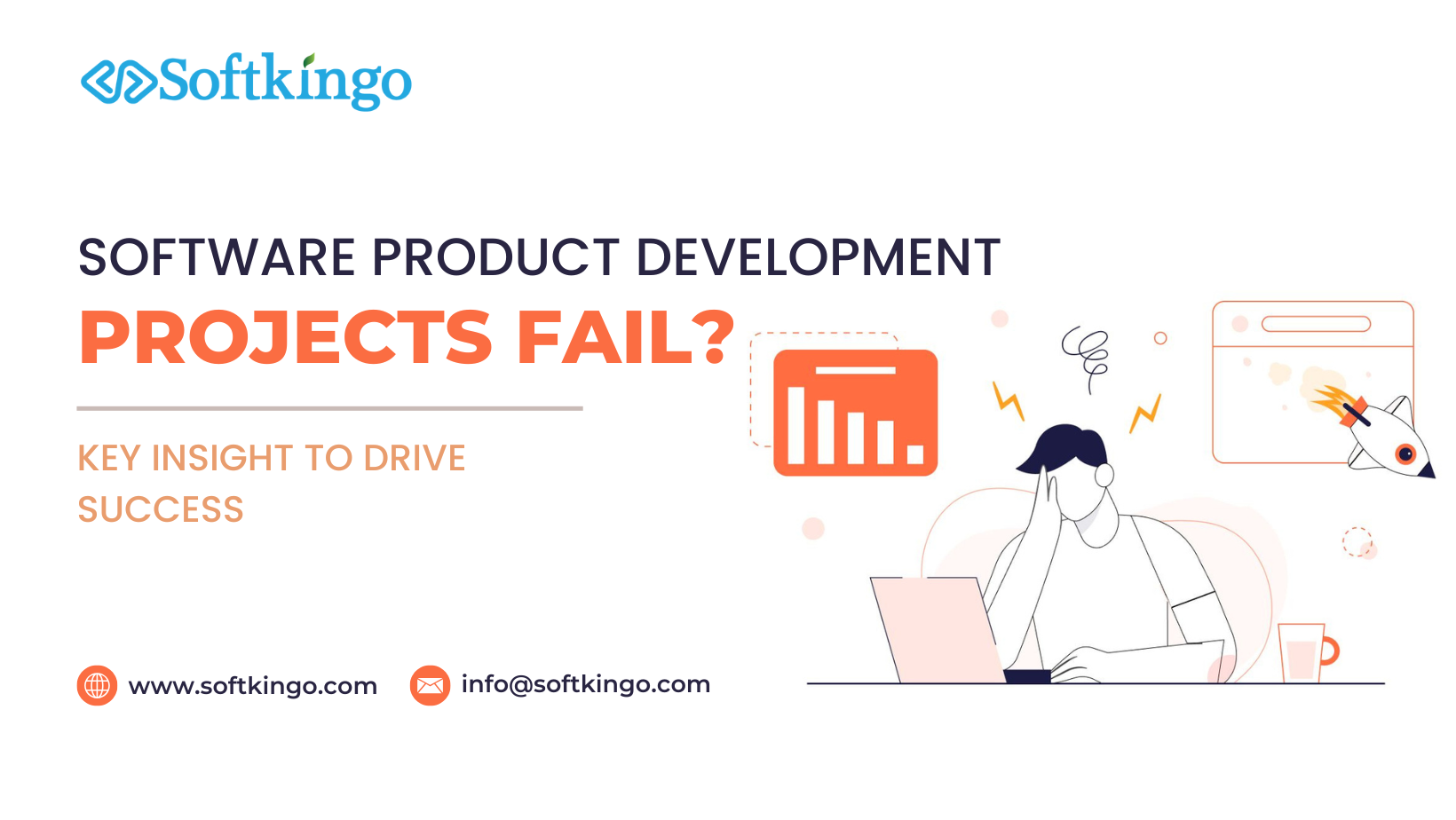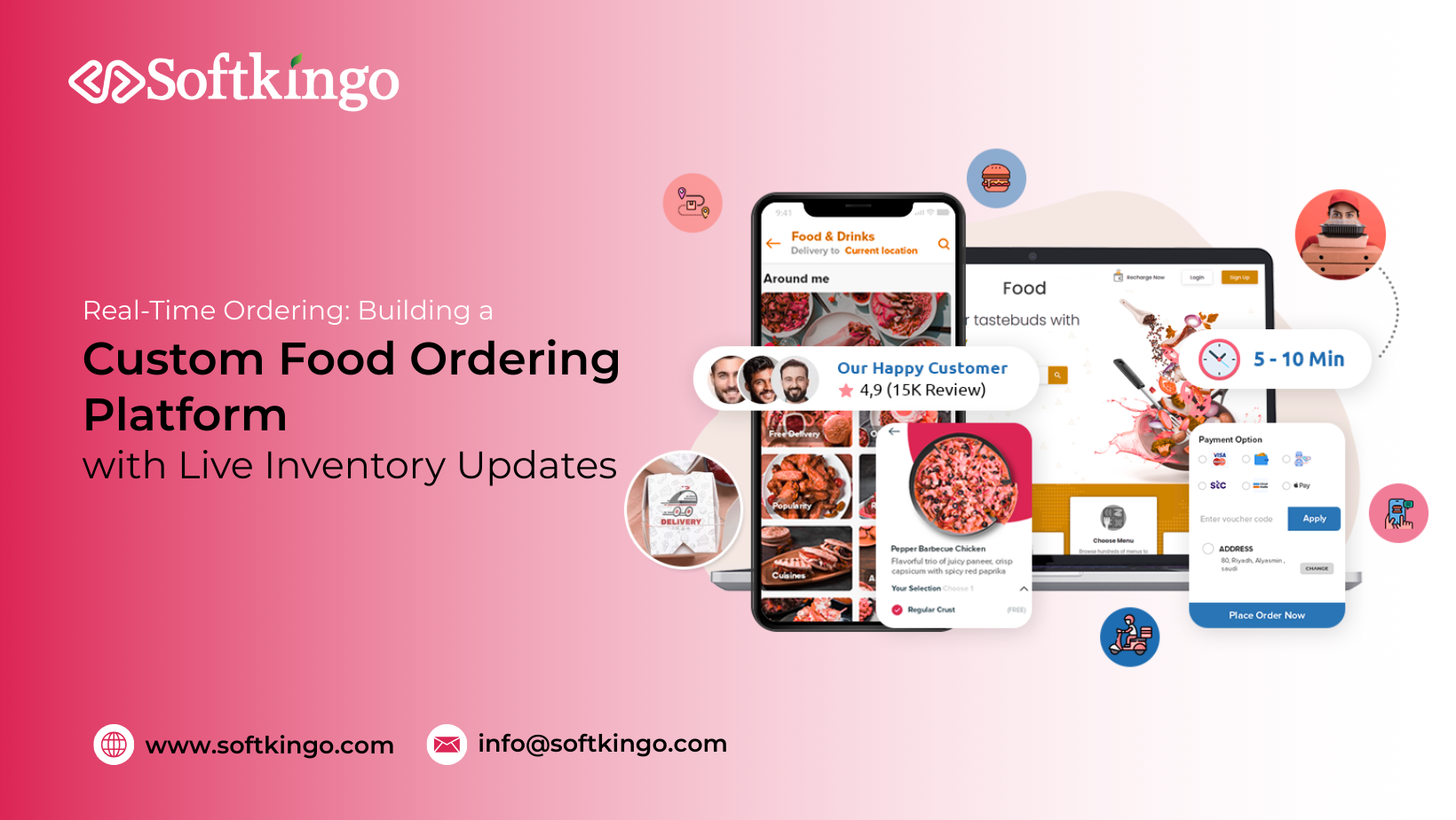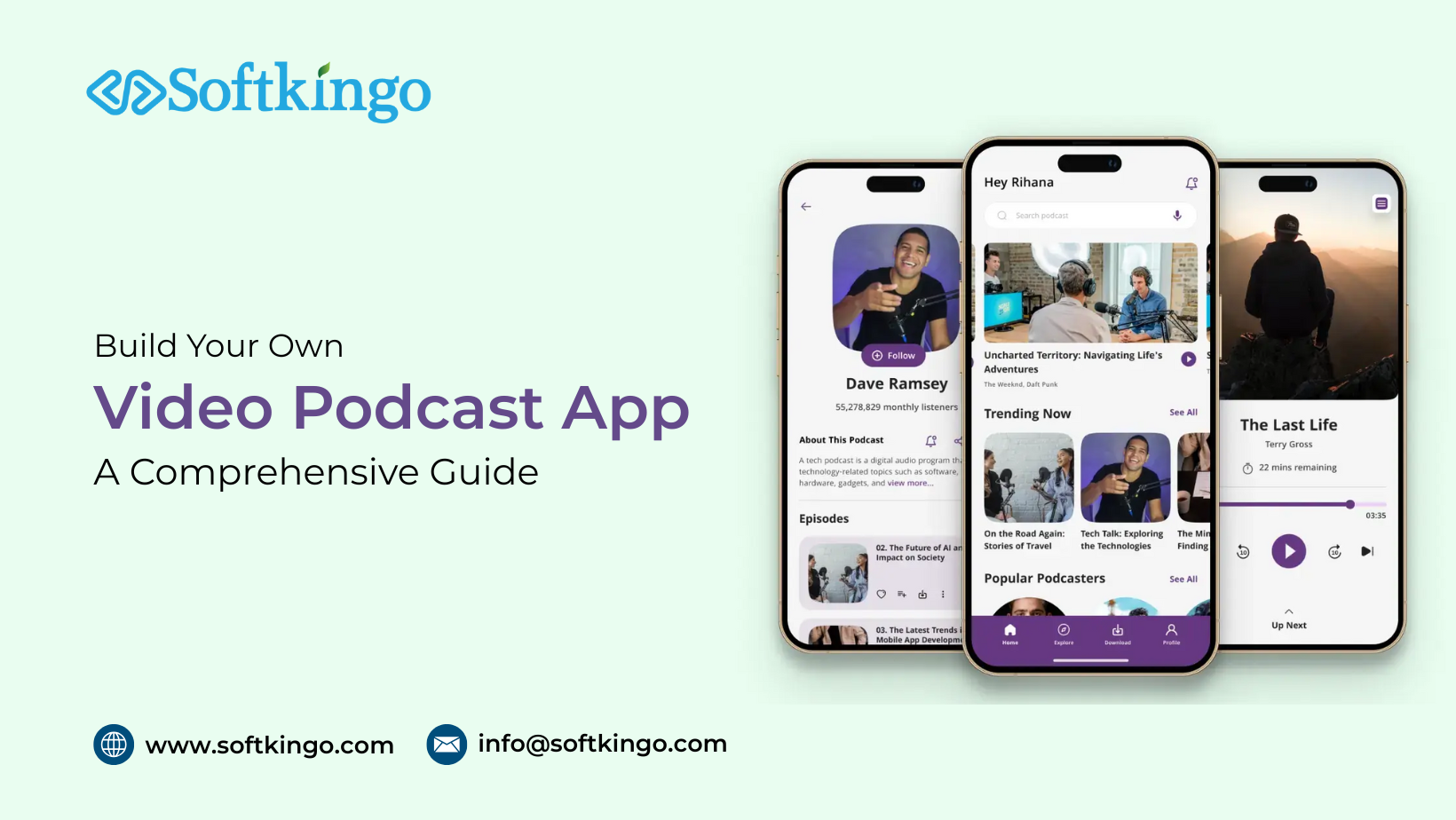Why Software Product Development Projects Fail? Key Insight to Drive Success
- 29 May 2025
-
 Paramhans Singh
Paramhans Singh

Can you reduce all the risks of software development? No! But avoid the common pitfalls that bail so many projects straight into software failure.
Software product development is basically one of the operators of digital transformation within a present-day enterprise. But despite technical advances and practically mature software development methodologies, software projects still get canceled. These failures cause loss of money, delay market entry, and demoralize the team.
Yet, thanks to the evolution of software development practices, there is a shockingly high proportion of software projects that get aborted, ranging anywhere from 50% to 70%, depending upon the industry and research considered. Such failures wreak havoc with financials, harm brand standing, cause delays in market entry, demotivate teams, and much more.
But the real question is, why do so many software projects fail? And more importantly, what can be done to ensure your software product sprints from concept to launch and beyond?
This blog looks into the reasons behind a product's failure and gives concrete solutions on how they can be avoided, stemming from industry-best practices and real-world experiences.
Some Common Reasons Why Software Projects Fail
Developing software is somewhat less about writing code than solving problems. However, the road to building successful software is laden with hazard. Most projects begin with a great start but end disintegrating as a result of unnecessary issues.
Let’s review the common causes of failure for software development projects and identify them before it's too late.
1. Not Starting with the User’s Needs
Let's be honest: Why create products that nobody finds useful? This is the biggest cause of enterprises failing when it comes to new products.
Posteriorly, without conducting proper user research, there is always a risk of creating something pretty but meaningless. User research involves interacting with potential users and gaining a deeper understanding of their problems.
For example, you intend to launch a task management app and have no idea how your users organize their day. You might have flashy features, but you are actually creating something that lacks simplicity, speed, or even a mobile-first design.
Start with empathy. Interview your users. Map their journey. Let at least 60% of the feature decisions be based on their needs.
2. Unrealistic Expectations
Fast results is what everyone wants to get. But software development does not run on magic.
There may be stakeholders expecting a highly sophisticated application in two months with a handful of guys and no resources. Other ones may want "just one more feature" to be added every week. Thinking this way makes your team overworked and desperate to deliver something mediocre.
Hurrying teams will frequently skip testing, drain away good user experience, or accumulate technical debt, things that may not hurt now but sure will later.
Seters in the fields of dreams, but everything else in the universe is not against achieving unreachable goals. Break a project into phases and do less but very well.
3. Unreasonable Budget
Let's be clear: Budget matters. So does how you budget.
There are very few plans that aim to develop the most powerful product on a very limited budget that succeed. It would have included not testing the product to save on costs, hiring cheap and inexperienced developers, and cutting corners on good design.
One startup used nearly all of its budget on development activities only to completely skip quality assurance; the app was launched with numerous bugs, users began churning, and eventually, all the money was wasted.
Have budgets for ALL stages—design, development, testing, and post-launch support. Great software is an investment, not an expense.
4. Unclear or Constantly Changing Requirements
You cannot hit moving targets.
When the product requirements are unclear, or changing every week, then the team ends up delivering a product completely different from what was initially envisioned. Developers get frustrated; timelines start slipping; and what do you get-unified frustration-a very confusing product that almost nobody asked for.
It sounds very intimidating, but when there is only one change in requirement halfway through, it does not seem so bad. But if we keep changing the requirement every couple of weeks, it will be like building the same house over and over again with another set of blueprints.
Start working from good documentation, prioritize features, and use a formal change management procedure if changes have to be allowed.
5. Poor communication between teams
This is one of the primary reasons software development projects fail. For the very best developers to not build something correctly, they must at least be somewhat unsure regarding what they are building. Development teams - developers, Designers, Testers, business partners, etc. - enter conflicts and miscommunication, creating silos in development.
Specifications are misunderstood, bugs are lost in translation, and whole modules are cobbled together due to assumptions. Much like assembling a motor car, the designers have drawn up a bike, the engineers are building a boat, and the testers expect to find a plane. Complete chaos.
Consider occasions when they can meet regularly and sync efforts together. Consider collaborative tools like Slack, Jira, Notion, etc. Clarity versus assumption—always.
6. Over-Complexity
It is appealing to picture crafting-from-day-one-a-"one-size-fits-all" product. But complexity will kill. Trying to stuff in every single conceivable feature makes the software immensely difficult from any angle to use-from testing to maintenance. Instead of solving one main problemary, we end up with bloated destructive software.
Users do not want 30 tabs—they want one that works.
Begin with MVP. Test some and fix. One feature at a time for growth.
7. Inadequate Planning and Estimation
When talking about "planning" in development, they usually mean sticking to deadlines or hitting milestones. Planning also involves envisioning the overall scope of the project.
When teams don't plan well, they tend to underestimate project time, do not consider testing or bugs after launch, and spend their last few days fixing crucial problems. It's like the wedding planner forgetting to book a venue; poor planning is embarrassing and expensive.
Break the work into sprints. Add buffers. Plan for the unforeseen, as it will happen.
8. High Team Turnover
Once key developers or designers leave in the middle of the store, everything slows down. New members spend time gaining a knowledge of the codebase, tools, and team culture. Without proper onboarding or documentation, the whole project suffers.
That's like changing chefs halfway through an elaborate recipe, without written instructions.
Make onboarding guides. Document everything. Keeping morale high ensures people stay.
9. Lack of Technical Documentation
Imagine that you have inherited a car with no manual, no labels, and no clue how it works. So it is for maintaining and scaling software that never got documented properly. It's frustrating for developers and risky for your business.
Good documentation eases the lives of the present AND future teams.
Encourage the team to keep documenting as they go. A few lines today will save hours tomorrow.
10. No Disaster Recovery Plan
What if the server crashed? Or if somebody deleted critical data? Or if the new update broke everything?
Damage could be forever if you don't have a disaster recovery plan. Data loss is not something that can be easily recovered from. You may have angry users, and your reputation might take a hit. Backup systems should always be present. Set failover. Prepare for the worst, even if it never happens to you.
11. Late Testing
End-of-project testing might feel like a good idea; however, that is a risky proposition.
At that stage, the bugs are more complex to fix and more expensive to rectify. Also, the likelihood is high that you would miss an important thing. This is why testing needs to be carried through right from the beginning and through means of the entire life cycle of the development.
Think of obviously, testing as brushing your teeth; don't wait until your teeth fall out. Use automated testing, include QA from day one, test after every major update.
12. Ignoring User Input
Feedback is not just a post-launch activity; it is an activity that should be considered during the project.
Your building without users' involvement is building in the dark. What looks good to the team might annoy users in the real world.
One team received excellent internal feedback, but eventually, when the dashboard was launched into the real world, nobody seemed to understand how to interact with it.
How to Prevent Software Failure - Proven Strategies That Work
Software projects don't fail overnight; they find cause in factors: miscommunication, missed deadlines, unclear goals. The good thing, however, is that these reasons can be prevented through smart planning and a human-first view concerning new products.
Let's review six powerful strategies to keep software on track and efficient at delivering value.
1. Built for Users, Not Just Features
The ideal technical design fails when no one embraces it. Technically perfect, it is a complete failure.
Most failed endeavors begin when technical interests are selected ahead of user requirements. End users should be the focal point of every decision. Logical software development becomes illogical when developers fail to understand the problems, behavior, and obstacles of users.
What to do:
- Spend time getting to know your users through interviews, surveys, and feedback.
- Create user personas that outline their needs, objectives, and behavior.
- Engage actual users during early design and prototyping.
- Develop projects using Agile or Scrum to effectively manage scope and respond to changes thoughtfully as opposed to handling them haphazardly.
2. Define Clear Objectives and Requirements from Day One
Many projects cease to exist because no one agrees on an interpretation of "done."
If requirements are vague or continually changing, the teams get misaligned, features get endlessly reworked, and deadlines are thrown out the window. Clear goals that everyone shares keep the team focused and moving in the same direction toward that finish line.
How to make it work:
Authenticating requirements in a simple and visual format-in user stories, journey maps, or workflows.
Involving all stakeholders in the planning from the beginning and not just at the end.
Setting some expectations early on, such as what's going to be included, what's going to be left out, and how we're really going to know if we've been able to declare success.
Use Agile or Scrum practices for controlled scope and intelligent responses to change, instead of anarchic reactions.
3. Ideal Open Frequent Communication
There must be open communications between the team members, no matter how much of a superior technology they are equipped with, or otherwise, projects would break down.
Improper information exchange among developers, designers, testers, and clients will cause delays in the project, reworks, and an unhappy end-user, amongst all stakeholders involved. Regular, open, and clear communication between teams lowers risk and builds trust between individuals while aligning them towards a shared goal.
How to improve communication:
Hold regular stand-ups or check-ins to keep everyone in the loop.
Use collaboration tools such as Slack, Microsoft Teams, or Notion.
Encourage open, respectful conversations—especially when it concerns challenges.
Avoid overusing email. Important conversations should stay transparent through shared tools.
4. Think Small: Define a Minimum Viable Product (MVP)
Are you writing the perfect version now? Don't!
Late arrival thanks to perfectionism is expensive to a project without attaining expected goals. An MVP is a crude version of the product geared to solving just one important problem efficiently. Through an MVP, a company can go to markets quickly and thus let the users drive their product development before any other expansion, thus averting a failure of a new product.
How to approach it:
Identify the ONE feature that users most significantly demand.
Design experience around that feature.
Get early feedback and improve the product with every iteration.
Done is better than the best. Begin by giving your users some handy functionality with which to build the rest of the product.
5. Test early, then test continuously
Testing a product at the end is like reviewing a book after it has been printed.
Finding a bug during the early stage of development makes the cost of fixing it cheaper. When testing is delayed, productivity declines due to unaddressed issues and decreased usability quality, resulting in chaos at the final hour. Implement your testing method as a key pillar in the continuous development.
Testing should work for you by:
Unit-testing, doing integration tests, running automated test suites from early days.
For maximum benefit, do continuous code reviews and QA checks.
Let users beta test the product before the final launch.
Instead of being treated as a separate procedure, continuous testing must be entrenched in best practices. The more tests you run, the more confident you will be with your programming work.
6. Document Everything—Yes, Everything
A good documentation can prove to be a life-saver when people leave the team or when bugs surface months later.
With these consequences being suffered by the expansion of the project, as developers spend hours merely tracing the logic, while the onboarding processes get longer and crucially important project information seems to fall prey to the oblivion of non-existence, documentation does not
Bear in mind: it is not an extensive writing exercise. One should instead aim to keep documentation of information that is important as simple and accessible as possible.
Documentation covers:
The major decisions and reasons for those decisions.
Code structure and architecture.
Instructions for setting up the project, operating features, or troubleshooting common problems.
Keep docs short, succinct, and easily searchable. Some good documentation tools would include Confluence, Notion or GitHub READMEs.
Conclusion
Software product development never crashes due to technology failures; it crashes due to bad communication, unclear objectives, bad planning, and the lack of understanding of the end-user. The good news? Every one of these Software product development challenges is preventable.
Depending on clear requirements, good communication, good fair practice, and user involvement will give you an overwhelming edge in the quest for success. Whether you are building a simple app or a large-scale enterprise platform, just remember: Success is not about writing credits for creating the right product and way with the right people.
Frequently Asked Questions
How to manage software development projects?
Having a successful software project requires three factors: the objectives defined, people qualified, and the implementation for agile or scrum methodology.
Work needs to be broken down into smaller steps with realistic deadlines and continuous interaction of the team utilizing project tracking systems. The project plans should always be kept flexible with regard to risk mitigation to allow early involvement of stakeholders as long as the project is in line with the original goals.
Why do software development projects fail?
The primary causes behind software project failures include ill-defined requirements coupled with poor communication and unrealistic deadlines compounded by a distracted leadership style. Insufficient quality control testing, changing organizational needs, and limited budgets affect projects. As projects with incoherent guidelines and inconsistent user feedback drift into unforeseen directions, the end result is often a glaring disappointment for all involved parties.
How do you maintain best practices in software product development?
Software development projects succeed after research has gone into creating an MVP through Agile processes and active participation of users, and with greater focus on good code and early feedback loops. Keeping documentation well maintained, flexible development, continuous testing, and being open to changes during the development process define the successful software development process.
The Why of Bug and Failure Occurrence in Software?
There are quite a few things that cause failures and bugs: people working with such imperfect communication systems that these systems, with the complex relations in them, end up showing features that were not tested. Numerous things come about due to rapid changes in technology and hurried development schedules, together with exceptional situations that sometimes remain hidden until the time software reaches the end-user level.
Paramhans Singh is the CEO and founder of Softkingo Technologies, bringing over 8 years of experience in delivering custom software solutions that help startups and enterprises achieve their business goals. He has successfully validated more than 220 app and website ideas and delivered over 100 tailored solutions, utilizing a range of technologies such as Swift, Kotlin, React Native, Flutter, PHP, RoR, IoT, AI, NFC, AR/VR, Blockchain, and NFTs.
















